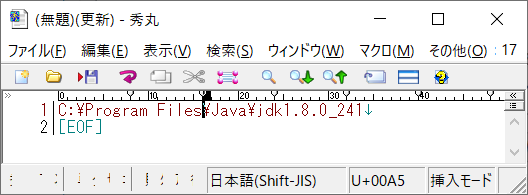[JAVA] PATH does not pass ... The cause is the character code
I installed the JDK on my new PC and set the environment variables. Then execute the javac command ...

Well, I can't find any mistakes when I recheck the environment variable settings.
I thought that it might be a character code problem, so I checked the character code of the entered path.

Apparently, the yen mark was ** U + 00A5 ** instead of ** U + 005C **. In the first place, the yen mark we are typing on the Japanese keyboard of Windows is not actually a yen mark, but a ** temporary backslash figure **. (To be precise, you can also enter a yen mark) The reason why this happens is that in Japan, the yen mark was assigned to the character code 5C, which was originally assigned the backslash character in ASCII, and it was standardized as JIS X 0201. After that, by trying to unify the character codes all over the world, the Unicode standard was born, and I tried to define the backslash and the yen mark properly. At that time, a backslash is assigned to ** U + 005C ** and a yen mark is assigned to ** U + 00A5 **. However, when Windows converted to Unicode, he said, "The character code of U + 005C is a backslash, but it is a yen mark in Japanese display." Therefore, when you enter a backslash with a Japanese keyboard, a yen mark or a backslash may be displayed on the screen depending on the font. (Actually backslash) In other words, when we usually type with a Japanese keyboard, even if the characters we type are displayed as yen marks, they are ** really backslashes ** (character code is U + 005C). However, when you copy and paste from somewhere, you may bring a real yen mark (character code is U + 00A5).
Well, the explanation is long, but in my case this time I copied and set the path, so (for some reason) I used the real yen mark. So, if you input it properly from the keyboard and set the environment variable,

In this way, the javac command was successfully executed.
Recommended Posts